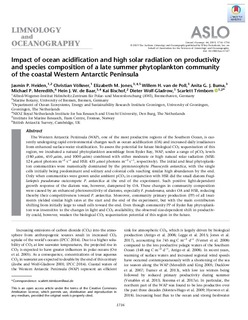| dc.description.abstract | The Western Antarctic Peninsula (WAP), one of the most productive regions of the Southern Ocean, is currently undergoing rapid environmental changes such as ocean acidification (OA) and increased daily irradiances from enhanced surface‐water stratification. To assess the potential for future biological CO2 sequestration of this region, we incubated a natural phytoplankton assemblage from Ryder Bay, WAP, under a range of pCO2 levels (180 μatm, 450 μatm, and 1000 μatm) combined with either moderate or high natural solar radiation (MSR: 124 μmol photons m−2 s−1 and HSR: 435 μmol photons m−2 s−1, respectively). The initial and final phytoplankton communities were numerically dominated by the prymnesiophyte Phaeocystis antarctica, with the single cells initially being predominant and solitary and colonial cells reaching similar high abundances by the end. Only when communities were grown under ambient pCO2 in conjunction with HSR did the small diatom Fragilariopsis pseudonana outcompete P. antarctica at the end of the experiment. Such positive light‐dependent growth response of the diatom was, however, dampened by OA. These changes in community composition were caused by an enhanced photosensitivity of diatoms, especially F. pseudonana, under OA and HSR, reducing thereby their competitiveness toward P. antarctica. Moreover, community primary production (PP) of all treatments yielded similar high rates at the start and the end of the experiment, but with the main contributors shifting from initially large to small cells toward the end. Even though community PP of Ryder Bay phytoplankton was insensitive to the changes in light and CO2 availability, the observed size‐dependent shift in productivity could, however, weaken the biological CO2 sequestration potential of this region in the future. | nb_NO |
